Science Case 1: Detection and Characterization of Extra-solar Planets
Science Case 2: Stellar Populations, Chemical Evolution of the Milky Way and NearbyDwarf Galaxies
Science Case 3: Isotopic Ratios in Galactic and Nearby-galaxies Stars
Science Case 4: Physical Constants Measurements
科学目标
GTC高分辨超稳定光谱仪可以观测多种不同类型的天体,包括太阳系天体、银河系及近邻矮星系中的贫金属星、以及遥远的类星体。这台光谱仪可以帮助我们解答天体物理学中的一些非常重要的问题,例如:太阳周围是否存在像我们的地球一样的宜居行星?银河系是如何形成和演化的?物理学常数在宇宙的时空尺度上是否是一成不变的?
在过去二十多年里,人类对宇宙的认识发生了翻天覆地的变化,知道了太阳并不是唯一一颗带有行星的恒星。关于太阳系外行星形成和演化的理论模型得到了长足的进步,并且在未来还将进一步发展。
探测宜居里的行星
视向速度方法,又称“多普勒光谱学”,其原理是测量恒星收到行星的引力扰动而引起的视向速度变化。瑞士天文学家M. Mayor和D. Queloz在1995年用这种方法第一次探测到了围绕在类太阳星周围的系外行星——飞马座51b,二人也因此得到了2019年诺贝尔物理学奖。视向速度方法在太阳系外行星探测起步的前十五年里在该领域占据了主导性的地位。随后,美国航空航天局(NASA)发射的开普勒(Kepler)空间望远镜及其后续任务K2采用“凌星法”发现了数以千计的系外行星。正在运行的凌星系外行星巡天卫星(TESS)预计将会发现几千颗系外行星候选体,其中可能包括数以百计的地球大小的行星。但是在已经发现的太阳周围的宜居类地行星候选体中,相当大一部分还没有得到证认。它们引起的主星视向速度变化幅度极小(通常只有几厘米/秒)、轨道周期比较长(通常大于300天),并且主星的视星等比较暗弱(通常暗于11等)。因此下一代视向速度测量仪器需要具有高分辨率、稳定的环境控制、以及大口径的望远镜。我们将要为10.4米加纳利大望远镜(GTC)研发的高分辨率超稳定光谱仪,视向速度精度可以达到10厘米/秒的量级,天文学家利用它有望探测类太阳星周围的宜居带里的低质量行星,即“地球2.0”。
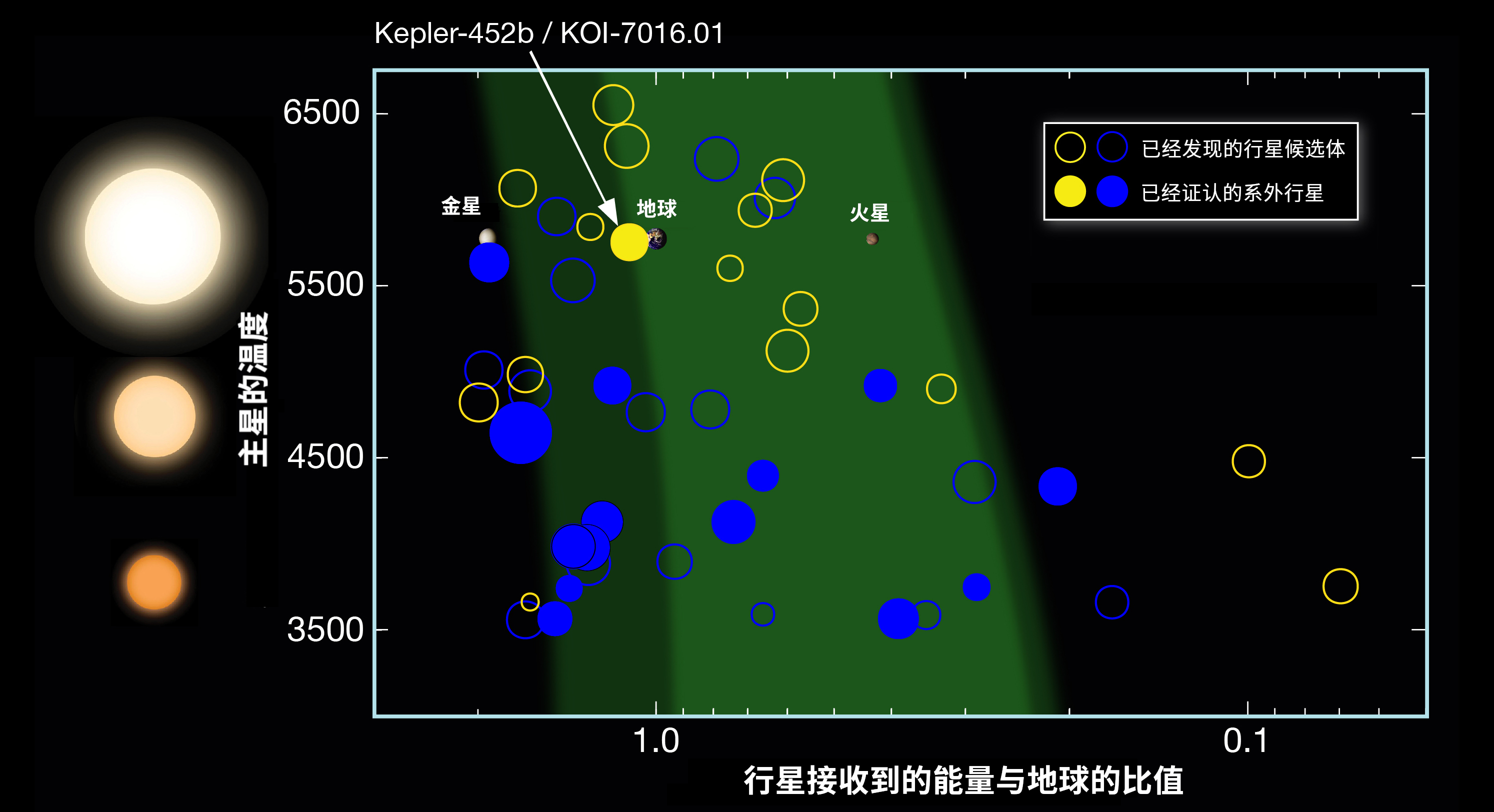
开普勒空间望远镜发现的位于主星宜居带里、半径小于2倍地球半径的行星候选体。其中标记为“新行星”的是Torres 等人在2015年用统计学方法证认的行星候选体。供图:NASA Ames/W. Stenzel
精细研究系外行星的大气
研究系外行星大气最常用的方法是测量凌星行星的“透射谱”。这种方法可以揭示系外行星大气的一些重要的物理和化学性质,例如是否存在原子、分子,是否有云层、尘埃或雾霾,大气中是否存在逆温层、是否有风、以及“逃逸流”等等。高分辨、高信噪比的透射谱是研究系外行星大气极其重要的诊断工具,能够帮助我们揭示其中发生的一些有趣的物理过程。这项研究的难点之一是如何在较短的凌星时间内获得信噪比足够高的透射光谱。加纳利大望远镜(GTC)的大口径结合高分辨率的光谱仪使这项研究成为可能。
测量凌星行星的质量
开普勒望远镜发现的凌星行星候选体中,超过80%是半径介于地球1.0到4.0倍之间的行星。但是这样的所谓“亚海王星行星”在我们的太阳系中并不存在。它们的化学组成如何?内部结构是怎样的?是如何形成的?这些问题给行星形成理论提出了巨大的挑战。开普勒望远镜发现了数目众多的行星候选体,但是其中很多并不能单纯依靠凌星方法测量质量。如果能够测量这些行星的质量,和半径参数结合到一起,就能直接告诉我们这些行星的平均密度,进而就能限制它们的化学组成和形成机制。加纳利大望远镜(GTC)与高精度、超稳定光谱仪相结合,未来有望在该领域取得领先地位。
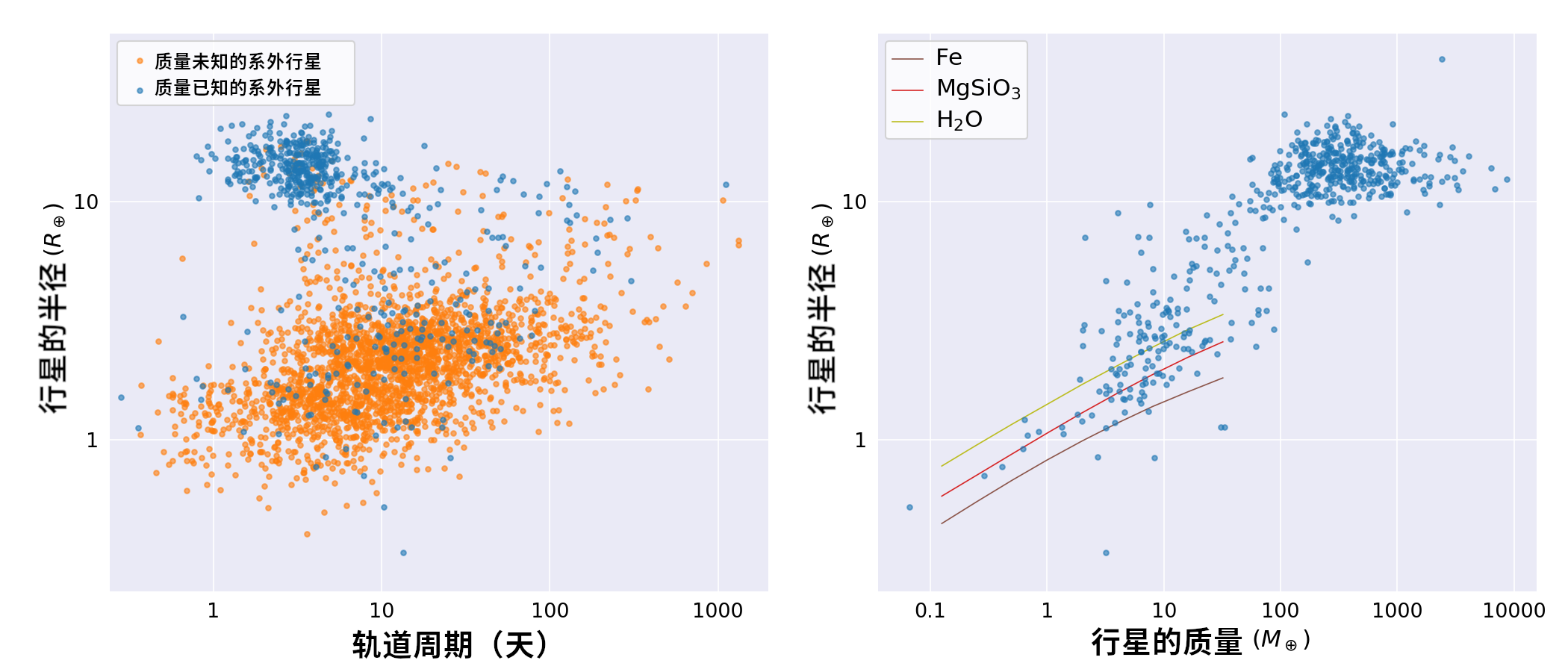
已经证认的凌星行星的轨道周期与半径的关系(左图),以及轨道周期与质量的关系(右图)。左图中的黄色点代表质量未知的行星,它们在右图中都是不存在的。右图中的实线代表不同化学组成的行星的轨道周期——质量关系(取自Zeng et al. 2016)。
测量行星的轨道倾角
行星公转轨道平面与恒星的自转平面之间的夹角可以告诉我们有关行星系统演化的信息。当凌星行星运动到主星的圆面前方时,我们可以观测到主星的视向速度有一个波动,这种现象称为“罗西特——马克劳夫林效应”(简写为RM效应),已经被成功地用于测量了几十颗行星的轨道倾角下限,发现很多行星的轨道倾角很小,还有一些行星是在“极轨道”上绕恒星公转的,甚至有反向公转的行星。这种效应对于热木星来说比较容易观测,但是对半径比较小的行星,以及多行星系统却非常困难。例如对于海王星大小的行星HAT-P-11b,其RM效应的振幅只有1.5米/秒。加纳利大望远镜(GTC)的大口径使得我们可以测量多行星系统,以及超级地球大小的行星的轨道倾角。
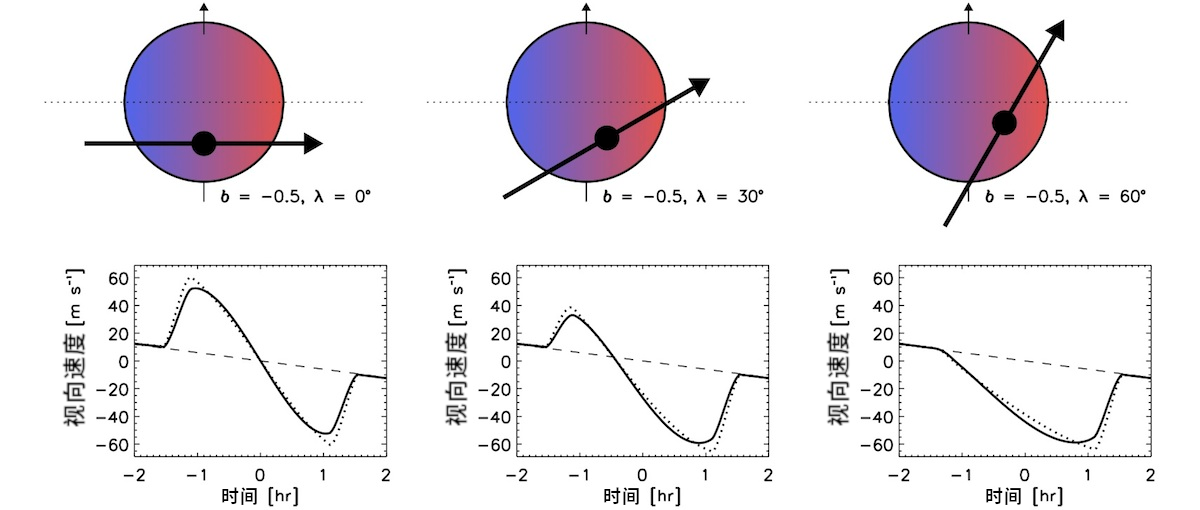
RM效应的示意图。恒星由于自转,其圆面中一半朝向观测者运动,另一半朝着远离观测者运动。当行星从圆面前方经过时,会挡住一部分光,谱线的左右两侧轮廓对称性会发生变化,导致测量到的视向速度曲线出现反常。根据反常的形状可以得到行星的轨道倾角。图片取自 WASP Planets
关于我们的银河系还有很多问题没有解决,例如,银河系的薄盘和厚盘是如何形成的?银河系的化学演化是怎么样的?银河系中最古老、最贫金属的恒星是否如理论预测的那样大多位于核球中?银河系的晕是否由已经瓦解的小型矮星系组成的?这些问题都可以利用加纳利大望远镜(GTC)这样的大型望远镜,对银河系和近邻矮星系中的恒星进行光谱观测来回答。
精细研究极端贫金属星
银河系和近邻矮星系中的极端贫金属星([Fe/H] < ?3.0)古老的化石样本,反映了早期宇宙中星际介质的化学组成。它们其中有一些只受到了宇宙大爆炸后不久单颗超新星爆发的影响,因此能够提供银河系形成之前,宇宙中第一代恒星的信息,也能帮助我们了解宇宙中第一代超新星的性质。最近几年来随着大规模测光和光谱巡天的快速进展,新的极端贫金属星不断被发现,金属丰度下限不断刷新,该领域得到了快速的发展。例如LAMOST巡天已经找到了数以万计的极端贫金属星,甚至有一些金属丰度([Fe/H] )小于?5.0的恒星。利用加纳利大望远镜(GTC)巨大的集光面积,天文学家可以深入地研究这些古老的化石恒星,极大地增进对早期宇宙以及元素核合成过程的认识。
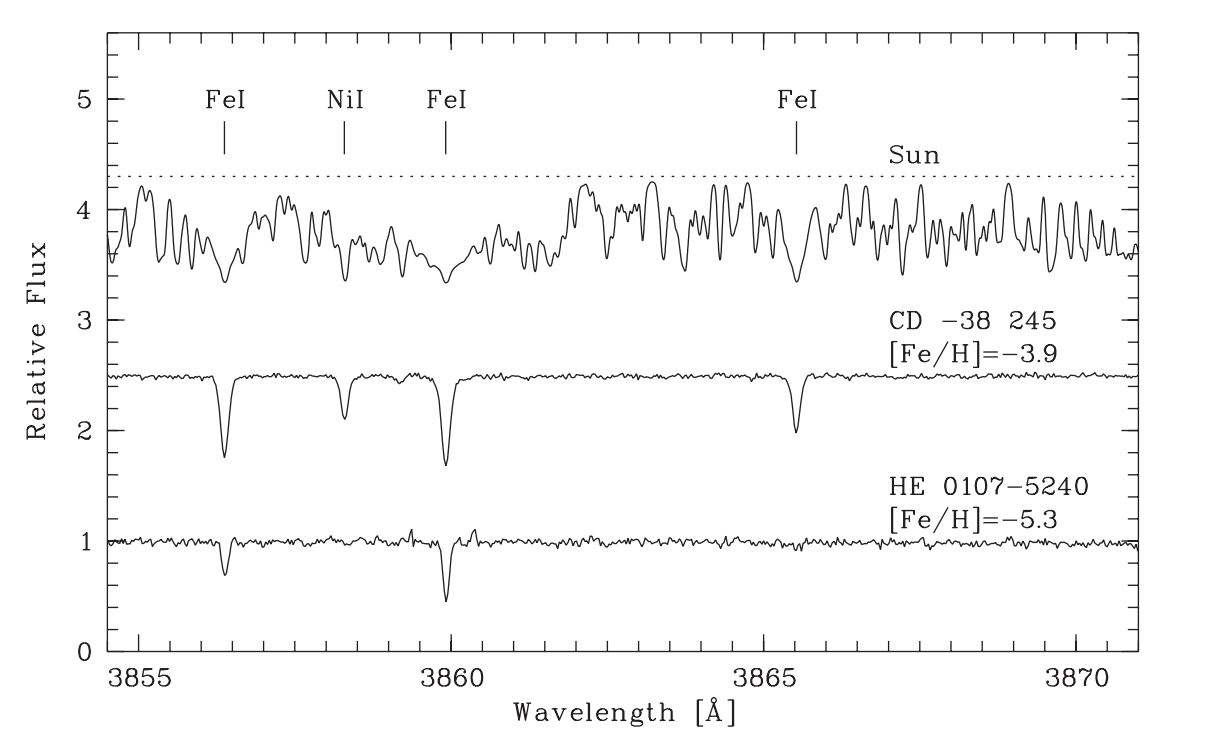
太阳(上)与两颗极端贫金属星的光谱比较。取自Christlieb et al., 2004
测定最古老恒星的年龄
一种经典的检验宇宙学模型的方法是将银河系最古老恒星的年龄与模型得到的宇宙年龄进行比较。古老恒星的年龄可以用一些半衰期较长的放射性元素的丰度来测定,例如钍-232(半衰期140亿年)和铀-238(半衰期45亿年)。近年来以LAMOST和SkyMapper为代表的大视场巡天项目发现了很多值得深入研究的古老恒星。利用加纳利大望远镜(GTC)的超强集光能力,天文学家只需要几个小时就能获得这些恒星信噪比大于500的光谱,可以用同位素方法测量它们的年龄。铀元素在恒星中的谱线很弱,要想测量到这些谱线,需要高信噪比的光谱和5万以上的分辨率。这些光谱还可以用来研究快中子过程元素增丰的贫金属星,进而为快中子模型(例如双中子星并合模型)和元素核合成模型提供有力的限制。最终,我们可以建立一个恒星重元素丰度的数据库,该数据库不仅检验宇宙学模型,还能够增进对宇宙中各种元素产生过程的认识。
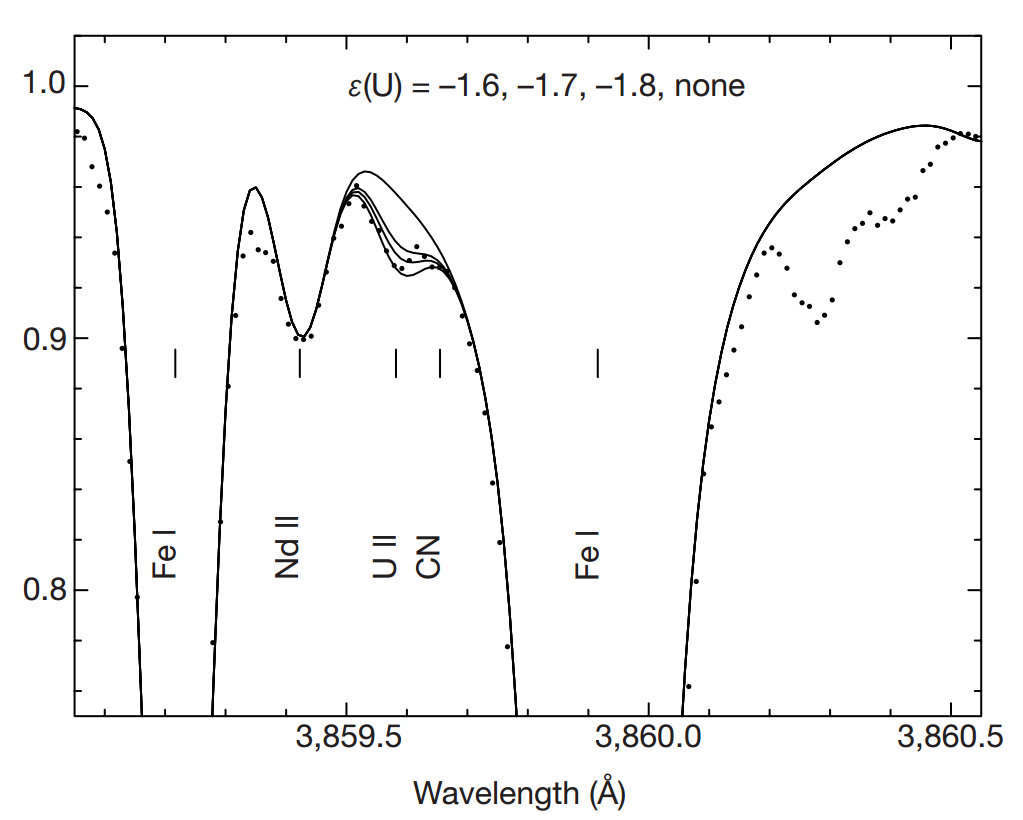
极端贫金属星CS 31082-001光谱中一次电离铀的谱线。取自Cayrel et al. 2001
探寻银河系晕的起源
银河系的晕为比较星系形成模型和 ΛCDM框架下的分层并合模型提供了独特的实验室。理解银河系晕的形成和演化是当代天体物理学中的一个重大课题。研究银河系晕族恒星的化学组成、空间分布和运动能够回答很多重要的问题,例如银河系的质量分布情况、卫星系的吸积等。加纳利大望远镜(GTC)可以详细测量银河系晕中的遥远恒星的化学元素丰度,进而研究卫星系的吸积在银河系晕的起源中扮演了什么样的角色。
测量恒星的同位素丰度可以帮助我们洞察不同的场所发生的核合成过程、银河系的化学演化、恒星中发生的元素混合和扩散过程,以及恒星的演化。一般来说,一种元素的不同同位素是在特定的核反应中形成的。在可见光波段,通一种元素的不同同位素产生的谱线相互重叠,相对位移很小,因此探测极为困难。利用加纳利大望远镜(GTC)以及高精度、高分辨率(R>90,000)的光谱仪,可以获得恒星的高信噪比光谱,进而测量很多元素的同位素位移。
镁同位素比率
镁在天体物理中是一种很有趣的元素,因为它的三种同位素是在不同的场所合成的。其中镁-24占主要地位,是在大质量恒星内部的碳燃烧过程中形成的,而占次要地位的镁-25和镁-26主要是在中等质量的渐近巨星支(AGB)恒星中形成的。因此三种同位素的比率应该随着恒星金属丰度的变化而变化,而恒星的镁同位素比率反应了恒星的核合成历史,例如该比率是否在大质量恒星演化成超新星之前就发生了改变,其他过程是否也会对该比率造成影响,例如中等质量的AGB星。
锂同位素比率
当代天体物理中一个重要问题是,观测到的锂丰度的“Spite平台”只有根据标准大爆炸模型结合WMAPS对重子密度测量结果的预测数值的1/3。对此天文学家提出了几种原初锂丰度损耗机制来解释。这些机制可以用加纳利大望远镜精确测量球状星团中贫金属星的锂丰度来检验。要想解释银河系中锂同位素的复杂的丰度模式,化学演化模型必须考虑一些了解得尚不清楚的锂元素合成和瓦解机制。在锂元素的同位素中,锂-6纯粹是宇宙线与星际介质发生相互而产生的,而锂-7则有很多不同的来源,例如恒星核合成、大爆炸核合成等。理论预测锂-6的丰度应该与恒星的金属丰度具有相关性,但是对银河系晕中的贫金属星的观测表明,锂-6与锂-7的比率在早期宇宙中出奇地高。这个结果仍然具有争议,需要对更多的暗星进行更精确的测量加以解决,而该研究可以用加纳利大望远镜(GTC)进行。
碳同位素丰度
测量恒星的碳同位素丰度(碳-12/碳-13)不仅可以用于研究恒星外部包层的混合程度,也可以为贫金属富碳恒星的化学演化提供重要的信息,更是早期宇宙核合成的指标。
重元素的同位素丰度
研究银河系重元素的演化历史需要重建钡(Ba)、铕(Eu)等元素的奇数核同位素和偶数核同位素的比率,以及它们随银河系年龄的演化。钡、铕等元素谱线的同位素位移相对其谱线宽度来说非常小,但是一次电离钡和一次电离铕的奇数核同位素具有超精细结构(HFS),因此在恒星中可以测量它们的同位素比率。加纳利大望远镜(GTC)拍摄高分辨率(R>90,000)、高信噪比光谱可以帮助我们测量这些重元素的同位素比率。
根据传统的物理学理论,自然界的一些基本常数在任何时间、任何地点都具有相同的大小,否则测量结果就会随着时间和地点而改变。实验室使用原子钟可以将精细结构常数(α)和质子与电子的质量比(μ )的变化率精确到<10?16 年,而天文观测可以在更长的时间尺度(120亿年)和更大的空间尺度(150亿秒差距)上进行测量,进而对物理常数的变化更加敏感。通过测量遥远的类星体的谱线,可以测量到这些常数在宇宙历史上相当长一段时间内的变化。利用10米望远镜的优势,天文学家发现,精细结构常数(α)的数值可能在宇宙历史上变化了大约白万分之6。α和 μ万分之一的数值变化引起的谱线位置变化大约相当于20米/秒。与前一代仪器相比,欧洲南方天文台甚大望远镜(VLT)上的ESPRESSO光谱仪可以将这两个常数的变化率的测量精度提高至少一个数量级。在10.4米口径的加纳利大望远镜(GTC)上安装一台类似的仪器也可以精确测量α和 μ的变化。

利用类星体吸收线测量到的Δα/α在宇宙不同时期的变化。取自Wilczynska et al., 2020
Science Cases
GTC CHORUS will allow us to study various types of celestial objects, including solar system bodies, most metal-poor stars in the Milky Way and nearby galaxies, and distant QSOs. With its high spectral resolution and broad wavelength coverage, the instrument will help us to answer some of the most critical questions in astrophysics, for example, is there any habitable planet like our Earth in the solar neighborhood? How did the Galaxy form and evolve? And did the physical constants vary in the time scale of the Universe?
Science Case 1: Detection and Characterization of Extra-solar Planets
Over the last two decades, our knowledge of the local Universe has changed dramatically. It is noted that our Sun is not the only star hosting planets. Models for how exotra-solar planetary systems form and evolve have been significantly revised, and that pace is not likely to slow down at any point in the near future.
Detection of Habitable Terrestrial Exoplanets
The Doppler spectroscopy aims to measure the stellar radial velocity (RV), i.e., the movements of stellar spectral lines caused by the gravitational pull of the planets. It detected the first known exoplanet (51 Peg b) around solar-like stars (Mayor & Queloz 1995) and dominated this field in the first 15 years. The NASA Kepler/K2 space telescope has found thousands of planets using the transit method. The Transiting Exoplanet Survey Satellite (TESS) is expected to find another thousands of planet candidates, including more than hundreds of Earth-size planets. However, a majority of habitable terrestrial planet candidates orbiting solar-type stars have not been confirmed. It often involve small RV variations (down to only dozens of cm/s), long orbital periods (P > 300 days), as well as faint host stars (V ~ 11). Therefore, the next generation RV instrument shall have a high spectral resolution, an ultra-stable environment, as well as a large photon collecting area of the telescope. With a RV precision of 10 cm/s with the new high-resolution, ultra-stable spectrograph at the 10.4m GTC, astronomers will be able to explore the low-mass exoplanets in the habitable zone of solar-type stars.
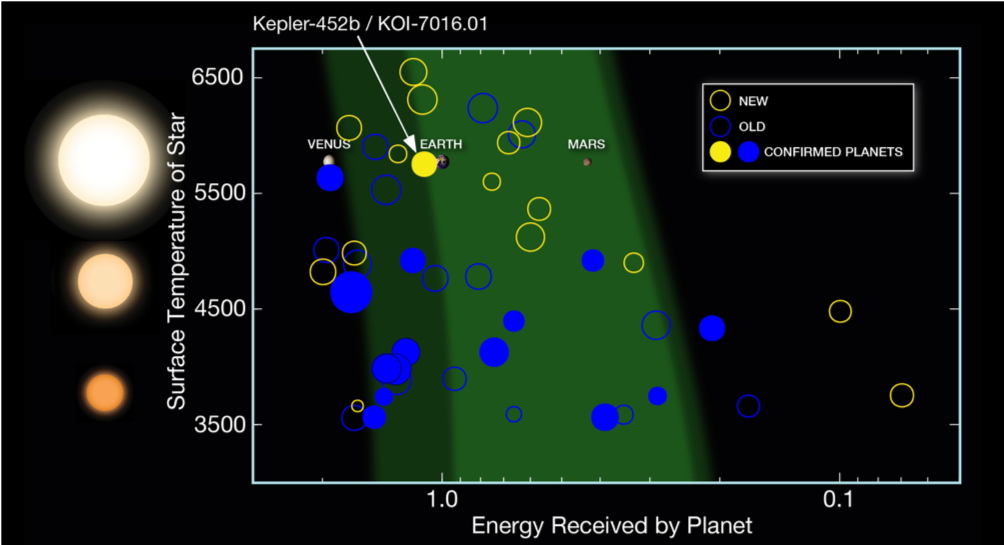
Planet candidates found by Kepler mission with radii less than 2R⊕ and obits in stars’ habitable zones. The “new” candidates refer to the habitable planets validated by Torres et al. (2015). Image Credit: NASA Ames/W. Stenzel
Characterization of Exoplanet Atmospheres
Transmission spectroscopy has become one of the most widely-used diagnostics about the atmospheres in exoplanetary research. Measurements of transmission spectra have revealed some essential physical and chemical properties of the atmospheres, such as the presence of molecules and atoms, clouds, dusts or hazes, thermal inversion layers, winds, and escaping flows. High-resolution and high signal-to-noise ratio spectra can be used as valuable diagnostics of the physical processes taking place in the exoplanet atmospheres. The critical limit of such work presently is the difficulty in obtaining many photons to produce a high enough S/N ratio spectrum during the short transit durations. GTC’s aperture will make it possible to achieve the required sensitivity during the transits.
Mass Measurements for Small-size Transiting Planets
Over 80% of the transiting planet candidates found by Kepler mission have radii between 1.0 and 4.0 R⊕. However, such planets are not present in our solar system. The chemical compositions, interior structures, and formation processes of these sub-Neptune-size planets proposed great challenges to theorists. The Kepler space telescope has provided a wealth of planets to study, but the masses of a large fraction of them cannot be determined with the transit method alone. Measuring masses for these transiting planets that already have measured radii will directly tell us their bulk densities, and therefore allow us to constrain the chemical compositions and formation mechanisms. Combined with the high-precision and ultra-stable RV instrument, GTC will maintain the leading position in the future competition for measuring the planetary masses.
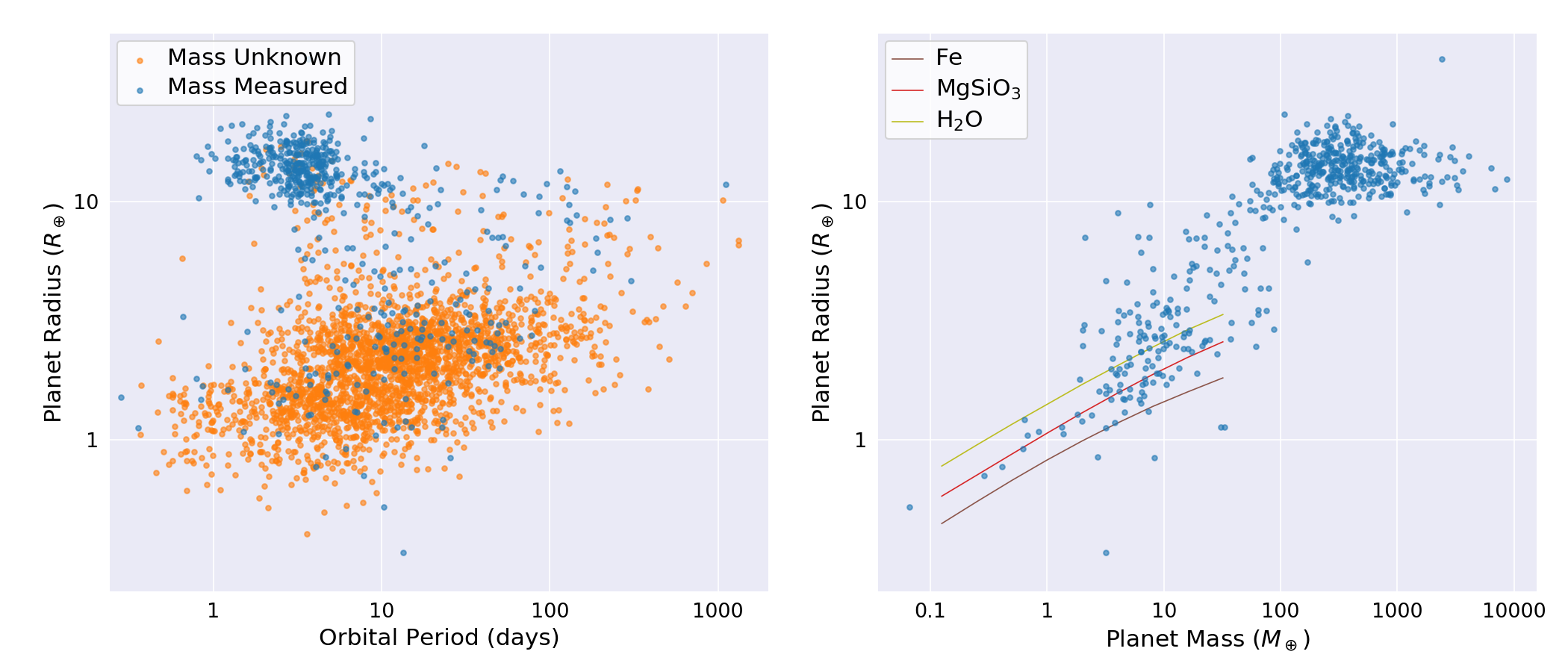
Period-radius relations of confirmed transiting planets (left) and mass-radius relations of transiting planets with mass measurements (right). Yellow points in the left panels represent planets with unknown masses and hence absent in the right panel. Solid lines in the right panel show planetary interior models for different compositions (Zeng et al. 2016).
Spin-orbital Alignments of Small-size Planets
The angle between the planetary orbit plane and the plane of stellar rotation is the probe of the dynamical evolution of the planetary system. The observed radial velocities exhibit a wobble as the planet transiting the disk of the host star. This phenomenon was named the Rossiter-McLaughlin (RM) effect, and has been successfully used to measure the sky-projected angles of the true orbital inclinations of several dozens of planets, including some well aligned planets, and also some polar-orbit or even retrograde planets. However, the spin-orbital alignments of small-size planets and multi-planet systems are quite challenging to observe. For the Neptune-sized planet HAT-P-11b, the amplitude is only 1.5 m/s. The powerful ability of the 10.4 m aperture enables us to measure the spin-orbital alignments of these multi-planet systems, and also small planets down to the size of super-Earths.

A schematic view of the Rossiter-McLaughlin effect. Due to the stellar rotation, one quadrant of its disk is seen to be coming towards the observer, and the other quadrant to be moving away (upper row). As the planet transiting the star, it blocks part of the stellar disk, causing a distortion of the spectral lines. The resulting RV shows an anomaly during the transit, as shown in the lower row. Image Credit: WASP Planets
Science Case 2: Stellar Populations, Chemical Evolution of the Milky Way and NearbyDwarf Galaxies
Many key properties of the Milky Way are not well understood. Such as, how did the thin and thick disk assemble? What was the Galaxys chemical evolution? Are the oldest and most metal-poor stars mostly located in the bulge as simulations suggest? Is the halo made from shredded, small dwarf galaxies? These questions can be addressed with large telescopes like GTC using spectroscopic studies of stars in our Galaxy and the Local Group dwarf galaxies.
Characterizing the Most Metal-poor Stars
The extremely metal-poor stars ([Fe/H] < -3.0) in the Galaxy and nearby galaxies are ancient fossil records of the chemical composition of the interstellar medium in the early Universe. They reflect the composition of individual supernova events after the Big Bang and thus can provide clues on the pre-Galactic phases and on the first stars that synthesized the first metals, and allow us to understand the characteristics and the yields of the first supernovae. The present decade will uncover new, extremely metal-poor stars through the next generation of photometric and spectroscopic surveys, thus advancing the field of stellar archaeology. For example, the LAMOST survey, has already provided about ten thousands of extremely metal-poor stars, as well as some objects with [Fe/H] < -5.0. With the light-collecting power of GTC, it will be possible to investigate these fossil stars with the required precision to generate a much-improved understanding of the early Universe and nucleosynthesis.

Spectrum of the Sun compared with those of two extremly metal-poor stars. Image Credit: Christlieb et al., 2004
Age Dating the Oldest Stars
A classical test of Cosmology lies in comparing the ages of the oldest stars in the Galaxy with that of the Universe as inferred from cosmological parameters. The ages of the oldest stars can be directly determined by measuring the abundances of long-lived radioactive isotopes such as 232Th (half-life 14 Gyr) and 238U (half-life 4.5 Gyr). Candidates for the further study come from large area surveys of very metal-poor stars such as LAMOST, SkyMapper, etc. Combined with GTC’s optical high-resolution spectrograph, it will be possible to obtain spectra of stars suitable for nucleo-chronometric age determinations with S/N of 500 or more in just a few hours. This S/N and a resolution of R>50,000 are required to detect and adequately measure the weak U line. Spectra of this quality will also enable the detection of weak lines of several other rarely studied elements permitting a full chemical characterization of the r-process element enhanced metal-poor stars, and they will provide the ultimate empirical constraint for r-process modelling (e.g., the binary neutron star merger) and thus nuclear astrophysics. Ultimately, a large stellar database with measurements of the most massive chemical elements will not only provide a constraint on cosmological models but will also further our understanding of the production of the heavy elements in the Universe.
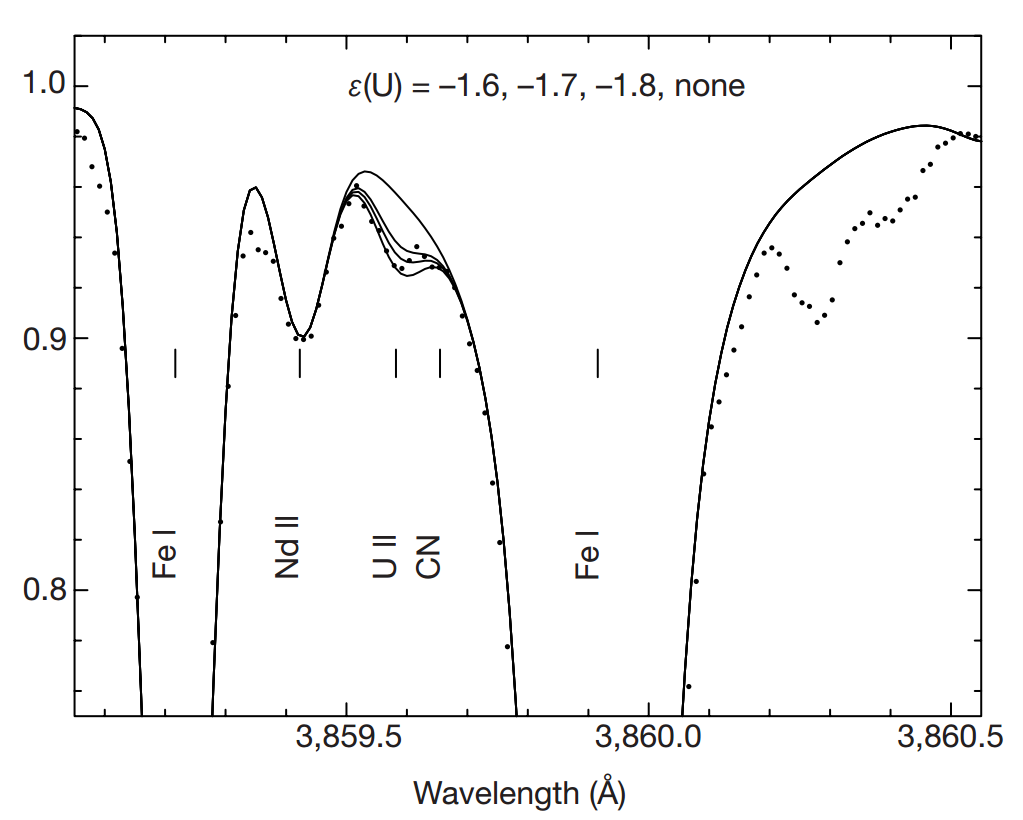
The weak UII line in the spectrum of extremely metal-poor star CS 31082-001. Image Credit: Cayrel et al. 2001
Probing the Origin of the Milky Way Halo
The Milky Way halo provides a unique laboratory for comparing galaxy formation models and the ΛCDM hierarchical merging paradigm. Understanding the formation and evolution of the Milky Way halo is one of the great challenges of astrophysics. Today, The compositions, spatial distribution and motions of stars in the distant Milky Way halo can simultaneously address a number of important scientific issues including, such as, probing the mass profile of the Milky Way, and quantifying the role of satellite accretion by identifying stellar streams. GTC will make significant contributions to quantifying the role of satellite accretion in the formation of the Milky Way halo. This will come about through GTC’s ability to conduct detailed abundance analysis of distant Milky Way halo stars.
Science Case 3: Isotopic Ratios in Galactic and Nearby-galaxies Stars
Measurements of isotopic ratios could provide significant insight into nuclear processes in various astrophysical sites, galactic chemical evolution, mixing within stars and stellar evolution. Isotopes of elements are produced through specific nuclear reactions. The isotopic shifts are very small and difficult to detect at optical wavelengths. High precision and high spectral resolution R>90,000 combined with high signal-to-noise ratios are required to measure isotopic shifts that is possible with GTC using a high-resolution spectrograph.
Isotopes of Mg
Magnesium is an interesting element because its different isotopes are produced in different sites. Among the Mg isotopes, 24Mg is produced as primary through carbon burning in the interiors of massive stars, while 25Mg and 26Mg are predominantly produced in intermediate-mass AGB stars. Therefore, the isotopic ratios are expected to increase as a function of the enrichment or metallicity. The measurements of Mg isotopic ratio are particularly important as they can provide clues to the nucleosynthesis history of a star, i.e., whether its isotopic pattern arises from pre-supernova evolution of massive stars, or whether additional processes, such as the contribution from intermediate-mass AGB stars, are required.
Isotopes of Li
The observed “Spite plateau” of A(Li) in low-metallicity halo stars shows a factor of 3 below the theoretical predictions of standard Big-Bang nucleosynthesis according to the cosmic baryon density provided by the WMAP results. Several mechanisms for the depletion of primordial Li in the surface layers of halo stars, such as internal stellar processes, atomic diffusion, mixing, and rotation etc. have been suggested in the literature. These predictions can be tested through accurate estimates of Li abundances in metal-poor stars of globular clusters using GTC. To explain the complex abundance patterns of Li isotopes in the Galaxy, chemical evolution modelling must consider several poorly constrained production and destruction mechanisms. The 6Li isotope is a pure product of interactions of the galactic cosmic ray with the interstellar medium, while it is known that the 7Li isotope has additional sources, like a stellar production and primordial nucleosynthesis. The Isotope of 6Li is expected to show a correlation with metallicity, while the observations of Li isotopic ratios in low-metallicity halo stars suggest a surprisingly high 6Li/7Li ratio in the early Galaxy. This result still remains controversial and needs to be verified with better observations and accurate estimates of Li abundance in the faint main sequence stars, which would be possible with GTC.
Carbon Isotopic Ratios and Cosmic Homogeneity
The carbon isotopic ratios of 12C/13C can be not only used to infer the degree of mixing of internally processed material with the outer layers of stellar atmospheres but also to obtain important clues into the evolutionary processes of metal-poor carbon stars. It is known that the isotopic abundances of carbon are indicative of the nucleosynthesis in the early Galaxy.
Isotopic of Heavy Elements
To reconstruct the evolutionary history of neutron-rich elements in the Galaxy, it is very important to disentangle the fractions of Ba and Eu even and odd isotopes and to inspect their abundance as a function of Galactic age. Isotopic shifts of the Ba and Eu lines are negligible compared to their line width. A determination of the Ba and Eu even-to-odd isotope abundance ratio in stars becomes possible due to the significant hyperfine structure (HFS) affecting the Ba II and Eu II resonance lines of the odd isotopes. The high-resolution (R > 90,000), high signal-to-noise ratio spectra from GTC will help us to measure the isotopic shifts.
Science Case 4: Physical Constants Measurements
In the traditional understanding of physics, the laws of nature have always and everywhere been the same. If it is not the case the fundamental constants may vary with the epoch and location of the measurement. Laboratory searches, notably those using atomic clocks, have limited relative variations in the fine-structure constant (α) and proton-electron mass ratio (μ) to <10?16 per year. However, astronomical observations probe much longer timescales and spatial scales (over 12 Gyr timescales and 15 Gpc spatial scales) and are therefore much more sensitive to possible variations of the fundamental constants than laboratory experiments. By exploring the spectra of distant quasars,the variability can be probed over a large fraction of the history of the Universe. With the advent of 10 m-class telescopes, observations of spectral lines in distant QSOs gave the first hints that the value of the fine structure constant might change over time, being lower in the past by about 6 ppm. A relative variation in α or μ of 1 ppm leads to velocity shifts of ~20 m/s between typical combinations of transitions. ESPRESSO on VLT is expected to provide an increase in the accuracy of the measurement of these two constants by at least one order of magnitude compared to UVES on VLT or HIRES on Keck. A similar spectrograph at the 10.4 m-GTC could also provide a significant improvement in the relative variation of the physical constants α and μ.

Direct measurements of Δα/α from from quasar absorption lines. Credit: Wilczynska et al., 2020
光谱仪 | GTC CHORUS